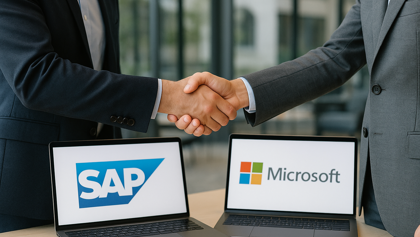How SAP and Microsoft Unlock Value Together
Choosing a new ERP system is no longer just about SAP or Microsoft. It’s about something bigger: how do you design your IT landscape in a way that lets you adapt to market changes without having to rebuild from scratch every time?

"It’s not just about ERP. It’s about staying relevant."
Edwin Buscher, Director Industry Manufacturing at HSO, explains how a hybrid IT landscape adds value to your business processes.
"You see companies still struggling with the question: where should I invest for the long term? I speak with many CFOs and CIOs who are thinking: this is the last major ERP migration we’ll ever do. So the pressure to get it right is high. And that means you have to look beyond your core processes."
"An ERP solution should strengthen your position within the ecosystem"
“Companies want to remain attractive to customers, partners, and new talent. To achieve that, you have to move with what’s happening outside your organization,” says Edwin. “That requires a different mindset: how you use your data, how you connect systems, and especially relevant in light of current developments, how you support decision-making with AI.”
More and more companies are shifting toward an ecosystem-driven approach. Instead of optimizing only internally, they look for ways to collaborate more effectively with suppliers, customers, and partners. That kind of collaboration requires access to data that goes beyond the boundaries of the organization.
The Role of Data: Connect, Understand, Apply
“Data is everywhere. In your applications, in your machines, in your customer portals. But if that data isn’t connected, you miss opportunities. With Microsoft technologies like Fabric and Azure Integration Services, we solve that. It gives you a foundation you can truly build on.”
Edwin explains: “More and more companies want to use AI for predictive capabilities. But AI is only as smart as the data it runs on. When you combine SAP with intelligent Microsoft solutions, you gain the ability to recognize patterns, predict trends, and make more targeted decisions.”
Real-world examples speak volumes
HSO has delivered hybrid solutions for companies like Heineken, Eneco, Stichd and BDR Thermea.
“Sometimes we extend SAP with Power Platform to automate processes more quickly,” says Buscher. “Or we use Copilot to give non-IT users easy access to SAP data. And with Azure Integration Services, we help clients connect SAP more smoothly to external systems.”
One strong example comes from an international manufacturing company. Buscher explains, “The goal was to onboard new entities quickly. Their SAP environment was solid but slow to adapt. By deploying Microsoft D365 at new subsidiaries, they were able to get started faster while still growing in line with the parent organization.”

"You don't have to overhaul everything to make progress"
Many organizations think they need to replace everything at once. That’s not necessary, according to Buscher: “You can build smartly on what you already have. Especially in large companies with an SAP competence center. Microsoft can add a lot of value without having to abandon SAP.”
“We also see that user experience plays a role. SAP is powerful, but not always user-friendly for everyone. With Power Platform, you can build specific apps that do exactly what’s needed, in a way people understand and enjoy using.”
A hybrid IT landscape is not temporary, it’s a strategy
According to HSO, choosing a hybrid approach is not a transitional phase, but a deliberate strategy. “It gives you flexibility and future-readiness. You get the best of both worlds.” Buscher concludes: “Our clients see immediate results. Better insights, faster decision-making, lower IT complexity. And maybe most importantly, they’re better prepared for what’s coming.”
Contact us
Curious how we can enhance your SAP environment? Get in touch with us!





